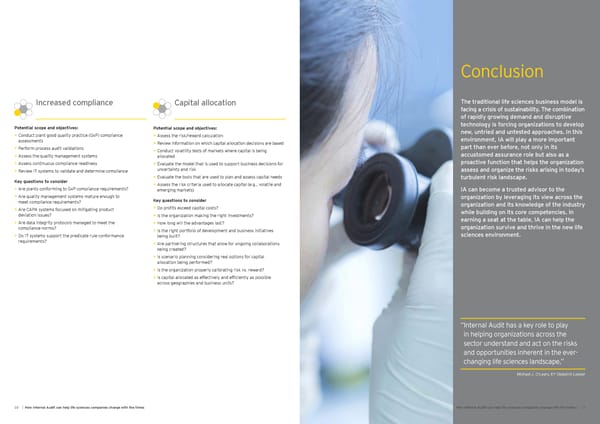Conclusion Increased compliance Capital allocation The traditional life sciences business model is facing a crisis of sustainability. The combination of rapidly growing demand and disruptive Potential scope and objectives: Potential scope and objectives: technology is forcing organizations to develop Conduct plant good quality practice (GxP) compliance Assess the risk/reward calculation new, untried and untested approaches. In this • • environment, IA will play a more important assessments Review information on which capital allocation decisions are based • part than ever before, not only in its Perform process audit validations • Conduct volatility tests of markets where capital is being • accustomed assurance role but also as a Assess the quality management systems allocated • Assess continuous compliance readiness Evaluate the model that is used to support business decisions for proactive function that helps the organization • • Review IT systems to validate and determine compliance uncertainty and risk assess and organize the risks arising in today’s • Evaluate the tools that are used to plan and assess capital needs Key questions to consider • turbulent risk landscape. Assess the risk criteria used to allocate capital (e.g., volatile and Are plants conforming to GxP compliance requirements? • • emerging markets) IA can become a trusted advisor to the Are quality management systems mature enough to • Key questions to consider organization by leveraging its view across the meet compliance requirements? organization and its knowledge of the industry Do profits exceed capital costs? Are CAPA systems focused on mitigating product • • while building on its core competencies. In deviation issues? Is the organization making the right investments? • earning a seat at the table, IA can help the Are data integrity protocols managed to meet the How long will the advantages last? • • organization survive and thrive in the new life compliance norms? Is the right portfolio of development and business initiatives • sciences environment. Do IT systems support the predicate rule conformance being built? • requirements? Are partnering structures that allow for ongoing collaborations • being created? Is scenario planning considering real options for capital • allocation being performed? Is the organization properly calibrating risk vs. reward? • Is capital allocated as effectively and efficiently as possible • across geographies and business units? “Internal Audit has a key role to play in helping organizations across the sector understand and act on the risks and opportunities inherent in the ever- changing life sciences landscape.” Michael J. O’Leary, EY Global IA Leader 10 | How Internal Audit can help life sciences companies change with the times How Internal Audit can help life sciences companies change with the times | 11
 Are you Ready for the Empowered Consumer? Page 6 Page 8
Are you Ready for the Empowered Consumer? Page 6 Page 8